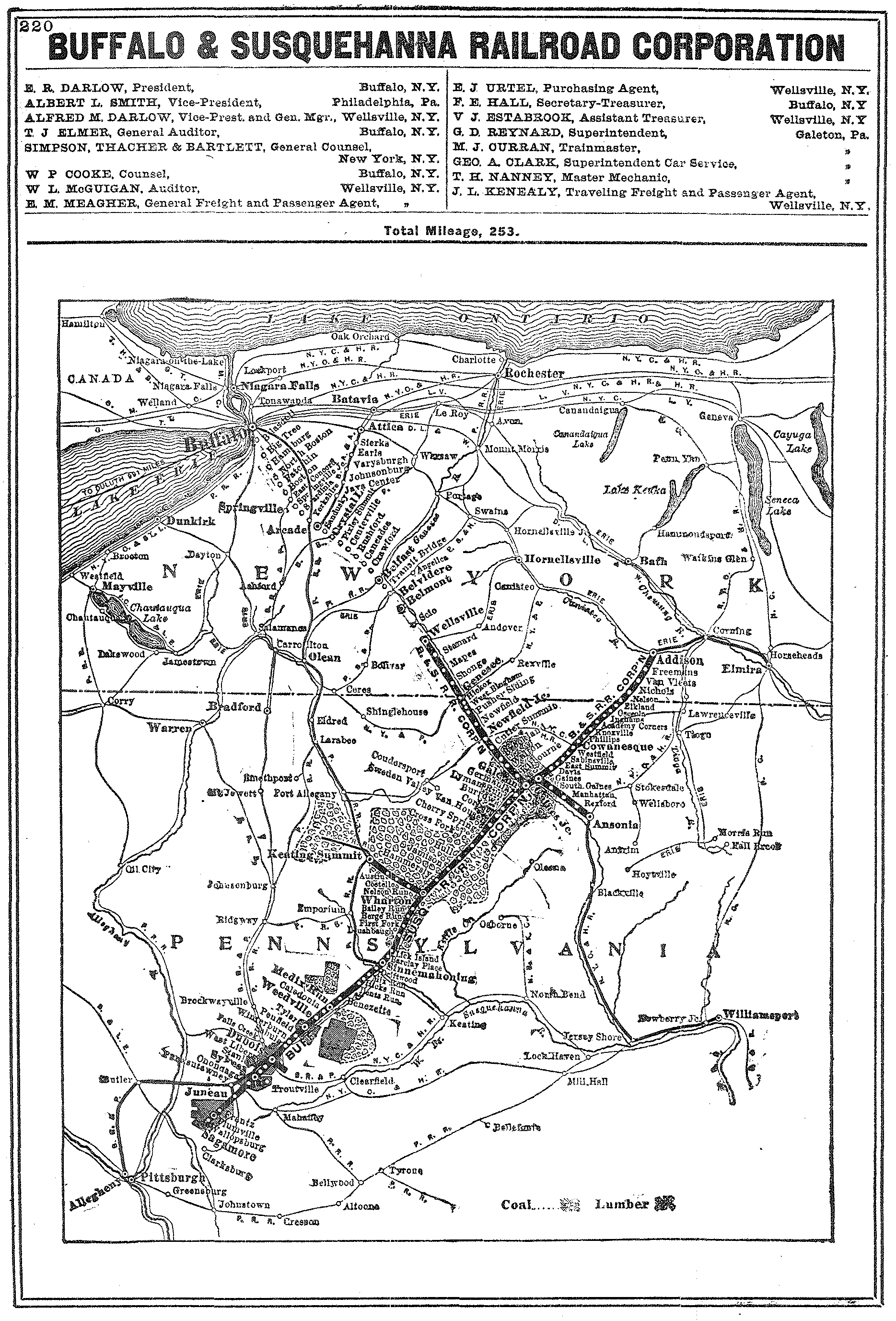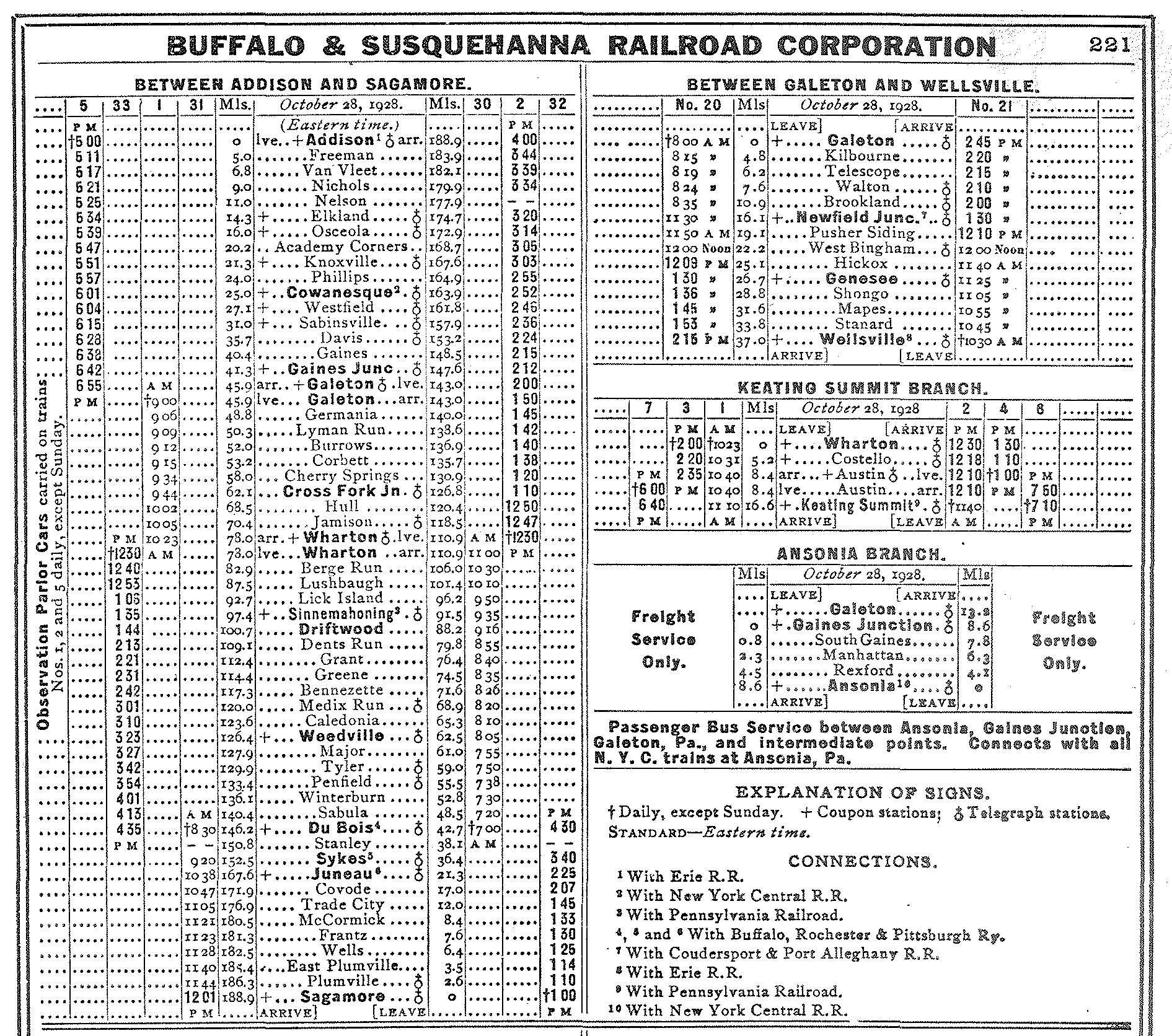Buffalo and Susquehanna Railroad: Map, History, Timetables
Last revised: August 22, 2024
By: Adam Burns
The Buffalo and Susquehanna Railroad was a railway company established in the late 19th century in the United States.
Its heritage can be traced back to a series of logging railroads constructed by Frank H. Goodyear to tap forests in north/central Pennsylvania and southwestern New York. They were later consolidated into the Buffalo and Susquehanna.
The railroad was primarily used to transport coal from mines near DuBois, Pennsylvania to Buffalo, New York. The company faced financial difficulties and was reorganized several times, eventually becoming part of the Baltimore and Ohio Railroad in 1932.
Beginnings
The Buffalo and Susquehanna Railroad, a rich vein in the intricate web of American railway heritage, traces its origins back to a group of predecessor railroads. Among them were the Sinnemahoning Valley Railroad and Gaines and State Line Railroad; both were built primarily to cater to the foreboding Pennsylvania lumber industry.
These predecessor lines were built in a pursuit to extract the economic value of vast timber resources present in north-central Pennsylvania. The construction of these railroads was mainly financed by notable lumber magnates such as Frank H. Goodyear and William A. Goodyear.
Goodyear Brothers and Logging Railroads
In 1885, Frank H. Goodyear, a Buffalo lumber dealer, purchased thousands of acres of Hemlock timberland in Pennsylvania. With softwood forests depleted, there came a demand for Hemlock despite its challenging features making it less attractive for experienced lumber operators.
To leverage his new investment, Goodyear organized the Sinnemahoning Valley Railroad, running from Keating Summit to Austin, Pennsylvania.
The railroad officially opened on December 14, 1885, built to a standard gauge for better future compatibility. Goodyear built a huge sawmill in Austin, where he transported all his timber by rail for cutting. In 1886, the line was extended to Costello, Pennsylvania to support a large sole leather tannery using the hemlock bark waste from the sawmills.
In 1887, Goodyear partnered with his brother to form F. H. & C. W. Goodyear, eventually owning most assets including properties, mills, railroads, and locomotives. In 1891, the railroad extended to Ansonia, crossing a large ridge with four large switchbacks instead of tunnels, limiting trains to 15 cars.
Formation
Throughout the early 1890s, multiple smaller lines were built linking up to Galeton and east to Ansonia. In 1893, the Buffalo and Susquehanna was created merging the Sinnemahoning Valley Railroad, Buffalo and Susquehanna Railroad, Susquehanna Railroad, Cherry Springs Railroad, and the Cross Fork Railroad. The railroad at that time spanned 62 miles from Keating Summit to Ansonia, with a 13-mile branch to Cross Fork.
During the late 1800s, the Buffalo and Susquehanna Railroad expanded and became served by a fleet of Shay logging locomotives alongside a Baldwin 2-8-0 locomotive, necessitating the purchase of eleven new locomotives in 1894 and 1895. The lumber and tanning business also expanded under the leadership of Frank Goodyear and his brother Charles.
Between 1895-1896, the railroad built a 37-mile extension, connecting Galeton to Wellsville, NY, and intersecting with the New York, Lake Erie & Western (Erie Railroad). Meanwhile, the Goodyears began to log newly purchased timberlands and established a large lumber mill in Galeton. They also became involved with the Wellsville, Coudersport and Pine Creek Railroad line.
In March 1896, the Buffalo and Susquehanna expanded to Corning, New York via trackage rights over the Fall Brook Railroad. By 1898, the Goodyears had accordingly purchased the Addison and Pennsylvania Railroad, thus facilitating a more direct route to Addison, New York, and they moved operations from Austin to Galeton, where they set up extensive train facilities.
By the late 1890s, the Goodyears had built a substantial lumbering operation in Pennsylvania. They employed 2400 personnel, operated extensive modern mills with the latest machinery, and ran 75 miles of logging railroads using their patented log loaders. At the height of operations, some of the mills operated almost round the clock.
Coal Traffic
As originally built, the Buffalo and Susquehanna primarily dealt with lumber's freight traffic. However, as the industry evolved, it also began handling coal, which became a significant commodity in the region.
In 1900–1901, the Buffalo and Susquehanna extended its mainline from Wharton, Pennsylvania, further south to the area of Du Bois, Pennsylvania by 1902–1905. This area turned out to be a hub of opportunities for lumbering and coal mining, fostering rapid growth for the Goodyear brothers' businesses.
They began purchasing coal mines, culminating in the creation of the Buffalo and Susquehanna Coal (and Coke) Company following the acquisition of Clearfield Coal Company in 1901. Additional coal assets were acquired from Berwind-White Coal Mining Company and Peale, Peacock, and Kerr Coal Company.
By 1904, the Buffalo and Susquehanna Coal and Coke company became the region's 6th largest mining company. With further acquisitions, the company's assets eventually amounted to an estimated 120 million tons of coal. Its largest mine, located in Sagamore, PA, was believed to have the capacity to mine 2 million tons per year.
To reach Sagamore, the Buffalo and Susquehanna had to build southwest of DuBois and lease trackage rights from the Buffalo, Rochester, and Pittsburgh Railway Company for 16 miles between Stanley, PA to Juneau, PA. The final 21 miles to Sagamore were owned and operated by the Buffalo and Susquehanna itself.
In 1902, Frank Goodyear created the Buffalo and Susquehanna Mining Company that leased iron ore land in Minnesota. To transport ore from Minnesota to Buffalo, they established the Buffalo & Susquehanna Steamship Company.
They incorporated the Buffalo & Susquehanna Railway in 1902 for transporting coal from Pennsylvania to Buffalo, and raised $17 million in public funding for railroad expansion.
In addition, they used a $15 million mortgage to further support operational expansion. This resulted in the construction of three large blast furnaces in Buffalo for processing the coal and ore, under the new Buffalo and Susquehanna Iron Company.
By 1906, the line to Buffalo was nearly completed, linking the Pennsylvania coal and timber lands to Buffalo's ore ships. Although the new route was longer and somewhat redundant, it marked a major accomplishment.
By 1907, the Buffalo and Susquehanna Railroad expanded to 250 miles from Buffalo, NY to Sagamore, PA, boasting over 400 miles of track.
The business shifted from lumber to coal and coke transportation, triggering an infrastructure upgrade and ordering of new cars and locomotives. However, following Frank H. Goodyear's death in May 1907, Charles W. Goodyear took over.
At its zenith, the Buffalo and Susquehanna Railroad covered an impressive total mileage of approximately 250 miles. It effectively linked various lumber mills and directly contributed to the region's economic expansion.
1910 Bankruptcy
The Buffalo and Susqeuhanna's operations peaked in the 20th century's first decade. The Buffalo extension, which was never profitable, losing $765,000 in 1910. On May 6, 1910, the railroad entered bankruptcy .
In 1913 the original property was reorganized as the Buffalo and Susqeuhanna Railroad while the Buffalo extension (Buffalo & Susquehanna Railway) was sold in 1915 as a separte operation.
Baltimore & Ohio
In 1932, the Buffalo and Susquehanna was acquired by the Baltimore and Ohio Railroad, marking a significant shift in its narrative. This acquisition marked the decline in its independent operations and embedded it in a broader network.
The B&O's purchase of the line was part of a larger initiative under President Daniel Willard to provide the major Class 1 carrier with a direct route from Pittsburgh to New York markets.
Havig also added the Buffalo, Rochester & Pittsburgh (which connected with the B&S at Du Bois), Willard's goal was utilize the B&S property as a linkpin in an extension that would eventually reach the Reading Railroad at Williamsport, Pennsylvania.
From this point the B&O would have enjoyed a direct routing to the New York, New Jersey and New England markets. Unfortunately, the economic conditions of that 1930s did not allow the B&O to complete its proposed Williamsport extension.
System Map (1930)
Wellsville, Addison and Galeton
A major turning point in the history of the railroad was the severe flooding in July, 1942. The devastating effects of these floods led to other sections of the railroad being abandoned, marking a major setback in its operations.
The last chapter in the story of Buffalo and Susquehanna came in 1956. The remaining segments were sold by the Baltimore and Ohio to form the Wellsville, Addison and Galeton Railroad. It was the end of an era, marking the railroad’s departure from the world of active railway operations.
The legacy of the Buffalo and Susquehanna in the fabric of American rail history is unmissable. From helping the lumber industry thrive to the technical challenges it overcame, the railroad etched deep marks in historical narratives.
Legacy
Without a doubt, the Buffalo and Susquehanna Railroad showcases an excellent example of how transport networks of the past were intertwined with the core industries of their respective eras. In this case, the flourishing lumber industry necessitated a robust and efficient railroad, and Buffalo and Susquehanna rose to the task.
The financial decisions underpinning the Buffalo and Susquehanna Railroad offer a glimpse into the enterprise systems of the late 19th and early 20th centuries.
From the infusions of funds by the lumber magnates to eventually being acquired by the Baltimore and Ohio Railroad, we see the movements of big capital during this formative period in industrial history.
Timetables (1930)
The railroad’s route through Pennsylvania and New York further emphasizes the strategic positioning of these north-eastern states in America's burgeoning industrial scene. Their abundant resources and easy access via the railway line led to their continuing growth and prosperity.
The Buffalo and Susquehanna posed an intriguing engineering challenge due to the severe grades and sharp curves it featured. This remarkable aspect of its design bears witness to the daring and ingenuity of 19th and early 20th century engineering.
The merger with the Baltimore and Ohio Railroad marked a notable shift in Buffalo and Susquehanna's trajectory. The entity it existed as was gradually absorbed into the larger system, marking the end of its independent journey.
The abandonment of the first sections of the Buffalo and Susquehanna Railroad was a visible symptom of the declining lumber industry. These abandonments marked the beginning of the end for the railroad, emblematic of the changing economic conditions.
The devastating floods of July, 1942, did more than just destroy parts of the track; they washed away a significant part of the railroad’s history, forever altering its future course.
The formation of the Wellsville Addison and Galeton Railroad signaled the end of Buffalo and Susquehanna Railroad's active operations. This monumental shift served as an epitaph to the dwindling significance and functionality of the earlier railroad.
Ultimately, the Buffalo and Susquehanna Railroad serves as a living history lesson, telling the tale of a bygone era where railroads like itself were the arteries of commerce, engineering marvels, and enduring symbols of resilience and adaptation.
The legacy of this illustrious railroad endures in our collective memory and continues to inspire academicians, historians, and railway enthusiasts alike.


